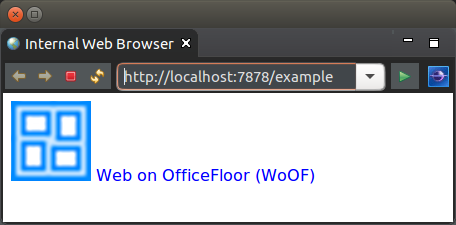Rendering Raw HTML Tutorial
This tutorial demonstrates the rendering of raw HTML for a WoOF web application.
The example used in this tutorial is the following simple page:

Template.woof.html
The HTML for the page is as follows:
<html>
<body>
${rawHtml}
</body>
</html>
This is similar HTML to previous tutorials.
TemplateLogic Class
The logic for the rendering the page is the following POJO (plain old java object).
public class TemplateLogic {
/**
* Able to use <code>this</code> as bean for populating.
*
* @return {@link TemplateLogic} to provide properties.
*/
public TemplateLogic getTemplateData() {
return this;
}
/**
* Provides the raw HTML to render. It is not escaped due to the
* {@link NotEscaped} annotation.
*
* @return Raw HTML to render.
*/
@NotEscaped
public String getRawHtml() {
return "<p style=\"color: blue\">" + "<img src=\"./images/OfficeFloorLogo.png\" />"
+ " Web on OfficeFloor (WoOF)</p>";
}
}
To generate HTML for the page and not have it automatically escaped by WoOF, annotate the property method with @NotEscaped. This informs WoOF to not escape the property value and render it as is.
This is a very simple example. More complex use of this would be presentation beans that provide dynamic generation of HTML. Please however consider using the ${bean ... $} tag first before generating raw HTML, as the tag will provide the necessary functionality in the majority of cases.
Next
The next tutorial looks at serving AJAX requests.


